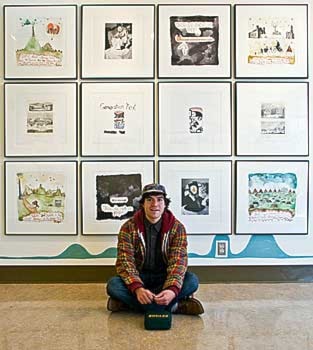For a naïve monkey, Curious George has a dirty mouth.
He’s at the Yukon Arts Centre community gallery cursing up a storm, chasing goats, dumping a mysterious liquid in an already brown river and riding in a hot air balloon.
Joseph Tisiga’s show, called Indigenous Incisions features the inquisitive ape, but he looks a little out of place in a landscape scattered with teepees and skyscrapers.
“Curious George was part of my life as a child,” said Tisiga.
“He was almost a friend, but the irony is he’s a monkey — a primitive being.
“And that’s how indigenous people are classified all over the world.”
Tisiga is a Kaska Dene.
He grew up in the Yukon, but never fit in.
“We moved around a lot,” he said.
His mom was forcibly removed from her family when she was small and placed in various foster homes.
“She had a family, but always a second-hand family,” said Tisiga.
And there were lost of issues with his dad’s family.
“It was a destructive environment and explosive,” he said.
But Tisiga doesn’t feel hard-done-by.
“There are obviously much worse situations, and obviously better, but you just have to grow up and let it go,” he said.
“The experiences I’ve lived have given me perspective on life.”
That perspective includes pop cans decorated in Tlingit designs, layered portraits of Picasso with his head cut out and an image of a teepee in its place, and a drawing of a cigarette with “This is not a pipe,” above it.
“I’m playing on icons of our recent past,” said Tisiga.
“It’s traditional imagery and Western cultural influences.”
It’s about assimilation, he added, referencing the Tlingit pop can.
Pop is poisoning people, said Tisiga.
“And diabetes in First Nation communities is through the roof. That’s the irony of traditional designs integrated into our Western culture.”
Tisiga wants to subvert Western culture’s dominance.
“I’m cutting into it, removing it from its context and putting it into a context that suites me,” he said.
“It’s me as an Indian getting into symbols of pop culture.”
Not only is Picasso’s familiar outline missing a head, there’s a print of Victorian houses with all the people and carriages cut out.
“I’m cutting people out of the environment as if they don’t exist — this is exactly what happened to First Nations,” said Tisiga.
Teepees, some with windows, sit beside historical buildings in a few of Tisiga’s drawings.
“It’s bizarre, a teepee with windows,” he said.
“I’m examining how we evolve into this dominant culture while maintaining our traditional roots and culture — how can we evolve while still remaining indigenous?”
But then, everyone is indigenous, added Tisiga.
Any person who identifies with where they’re from is indigenous, he said.
“While someone who is not indigenous doesn’t care about their home or their community. So they can exploit it to the bitter end because it has no value to them.”
Tisiga, who just started drawing a couple of years ago, plans to work on more projects exploring indigenous versus industrial mentalities.
He has plenty of plans in the works.
Tisiga also wants to make a painters suit, possibly out of buckskin, decorate it with Tlingit or Haida patterns and start painting traditional designs on people’s houses.
“It’s about personalizing objects,” he said.
“So it’s not just about objects but the relationship you have with them.”
Tisiga credits his mom, who was a social worker, for his ingrained social commentary.
But it’s only in the last few years that he’s started identifying with his First Nation heritage.
“It was pretty foreign to me, and at first I was embarrassed about it,” he said.
“When I was growing up, if it didn’t have to do with MTV or skateboards I didn’t give a shit.
“But there is so much more to the world than MTV and skateboards.”
Now, with so many subcultures, young people cling to what pop culture sells, said Tisiga.
“That’s why you see young First Nations from Mayo who think they’re rappers, even though they’ve never seen (this culture) — they cling to what they think is right.”
But holding on to First Nations culture in the face of Western values is next to impossible.
Even the creators of the award-winning Canadian film Atanarjuat, The Fast Runner, had trouble getting funding, said Tisiga.
“And it was because it was filmed in their traditional language.
“Imagine if I decided to write a book in Kaska — commercially it’s not viable.
“There’s only a few people who could read it, and of those even fewer would. It’s an issue for First Nations all over the world.”
However, Tisiga isn’t giving up.
“I feel I don’t have time to waste,” said the 24 year old.
“One day I’m 20 and the next I’ll be 40, and what did I contribute?
“I don’t want to be regretful and watch things unceremoniously fade away.”
Tisiga’s focus is aboriginal politics and identity.
“It’s all about belonging and making that accessible to people,” he said.
Aboriginal Incisions will be at the Yukon Arts Centre community gallery until the end of September.
